Art, Robots, and Chocolate at the Fall 2014 Media Lab Expo
Visitors and staff check out more than a dozen experimental projects and prototypes at the fall 2014 Media Lab Expo. All photographs by Yuliya Levit, except as noted
«Each semester Media Lab works with a group of college and graduate interns, exploring the ways that technology impacts, and is impacted by, the Museum experience. Media Lab interns are encouraged to think outside of the box, to engage deeply with the Museum's staff, collection, and visitors, and come up with novel prototypes that encourage conversation and spur new thinking about the relationship between contemporary digital practice and centuries of artistic tradition. At the conclusion of the internship, participants present their projects to the public at the Media Lab Expo. Visitors can try out hands-on demos and talk to the creators themselves about their work and ideas.»
On December 19, around 250 people attended the fall 2014 Media Lab Expo, held in the Uris Center for Education's Art Study Room. In addition to the fourteen intern projects, we also hosted start-ups with unique approaches to the use of technology in advancing the Museum's mission.
In the coming weeks, each participant will present a blog post detailing their research, ideation, and implementation of their projects. In the meantime, take a look at the project summaries and pictures below. We welcome your feedback, comments, and new ideas in the comments section at the end of this post.
Drawing Robot
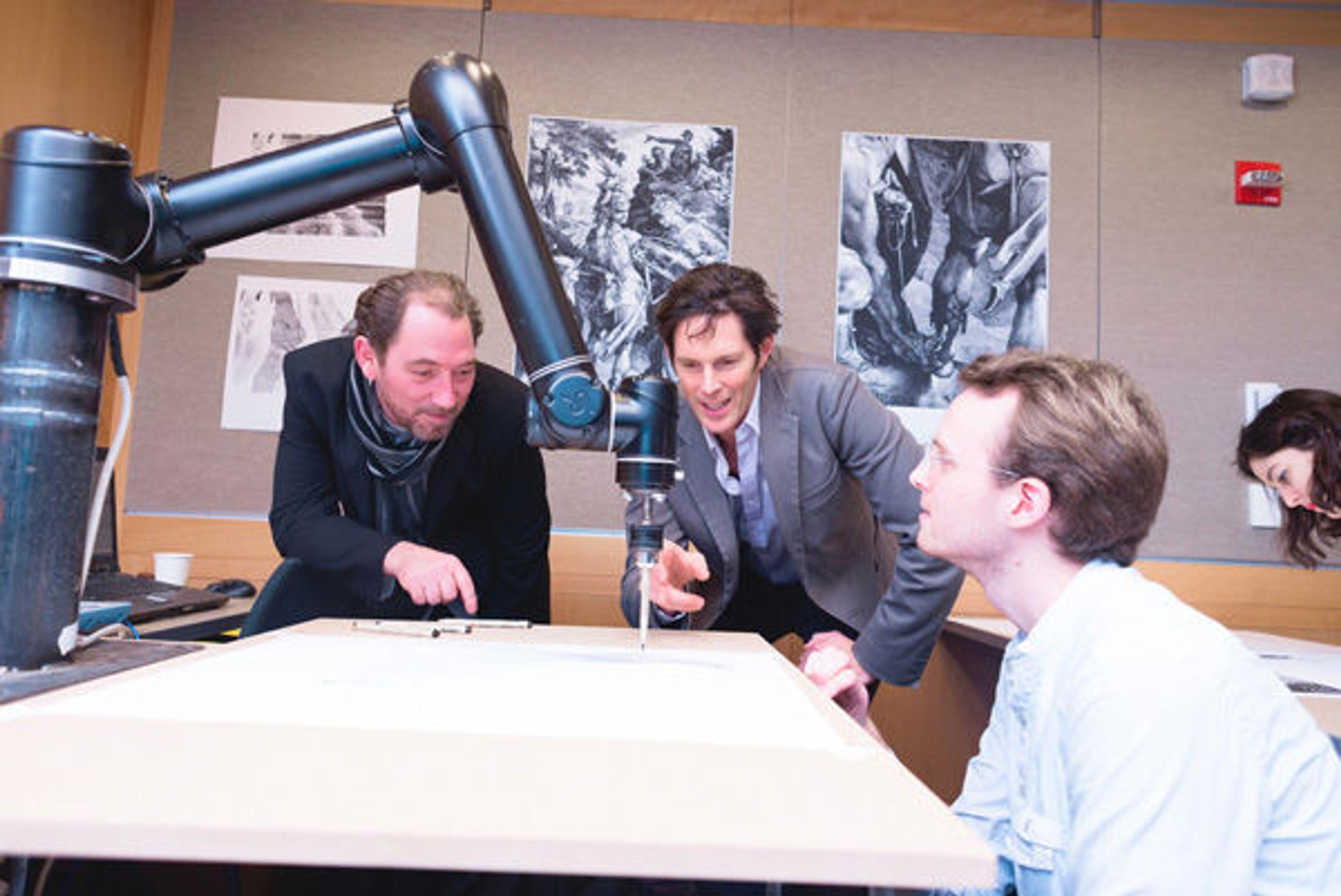
Mark Parsons (center), Cole Belmont, and Mark Kremer from the Consortium for Research and Robotics watching the UR-5 Robot arm draw
What does it mean for artistic practice that we can teach robots to draw? Is it just a natural evolution of our creative toolkit? What can robotics researchers learn from modeling traditional techniques in a new medium? Executive Director of the Consortium for Research and Robotics, Mark Parsons, alongside Cole Belmont, a manager in the firm, and intern Mark Kremer, helped us to scratch the surface of these questions by programming a UR-5 robot arm to draw copies of engravings in our collection, using precise control of a felt-tip pen to create the fine details of each line's width and texture.
Electric Objects

Left: Jake Levine and Zoe Salditch demonstrate the Electric Objects Digital Art Display. Right: The screen is designed to display art from the Internet onto your wall
Electric Objects is a New York City–based start-up developing a digital screen that displays art from the Internet onto your wall. They helped us imagine what the Met's content would look like on such a device by assembling a collection of compelling images and metadata for their prototypes. What Met objects would you like to see on a screen like this in your home?
Technkisi

Left: Jaskirat Singh Randhawa explains the theoretical underpinnings of Technkisi. Right: Technkisi in detail
Many objects in the Met's collection served as ritual objects in societies around the world at one time or another, and seeing them in a display case in our galleries can distance us from that context. However, in our efforts to restore context to these objects, do we create a new kind of distance, given our incomplete understanding of those societies?
Jaskirat Singh Randhawa addressed these questions in a novel way—by reimagining a Kongo power figure as a twenty-first-century ritual object, activated by a brain scanner and incorporating 3D printing, stepper motors, and hydraulics.
FEMET
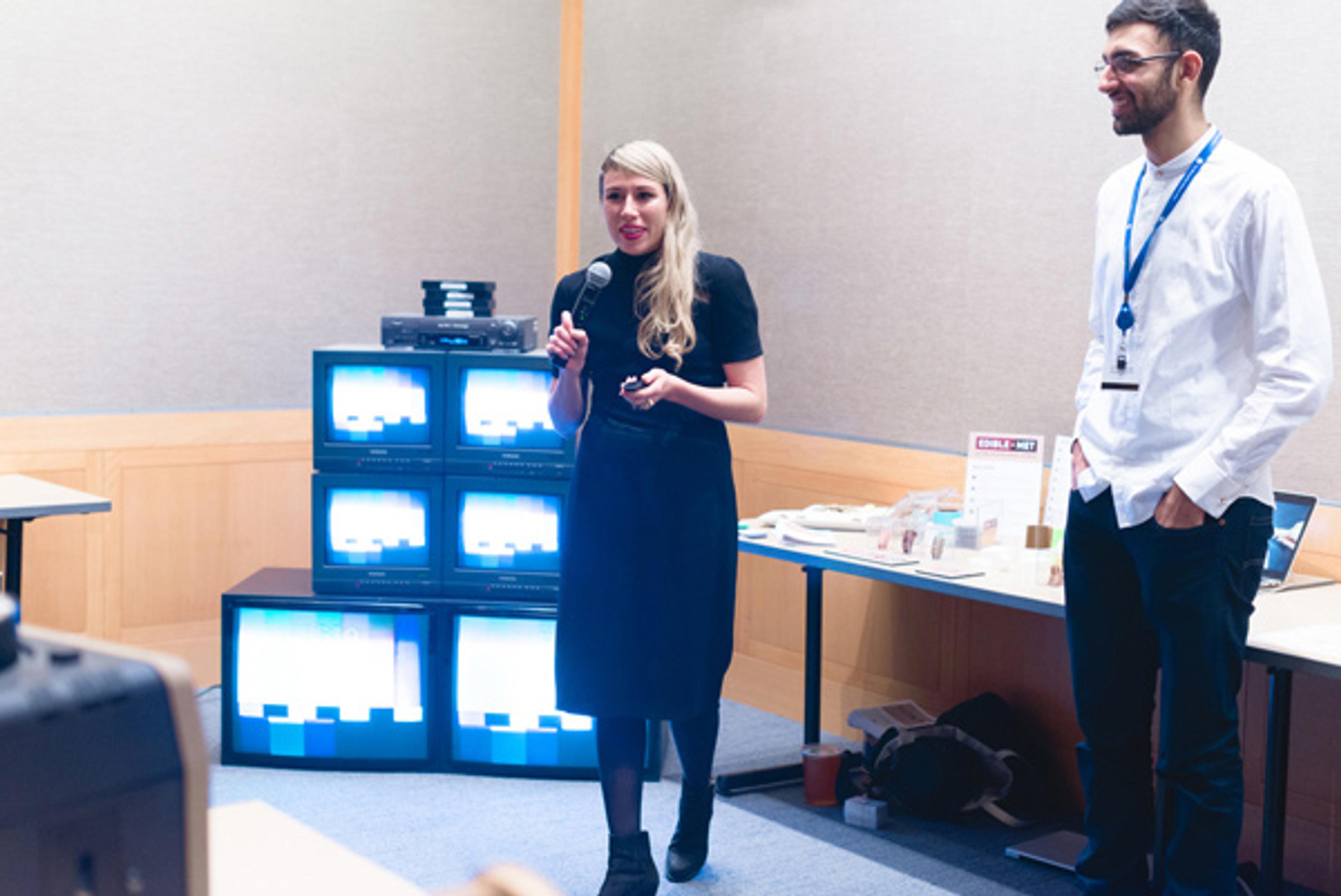
Joselyn McDonald presents FEMET
Joselyn McDonald's FEMET is a sound and video art installation that interprets and reflects the lives of five esteemed women artists in The Metropolitan Museum of Art's permanent collection. Through research, collaboration with Met staff, and interviews with living artists, McDonald developed a video installation that incorporated a network of archival equipment, video art, sound art, code, found footage, and preserved audio and video content. The installation represents a synthesis of her attempts to understand the plight of women artists by means of the production of new art.
AlterMet

Left: Michael Anzuoni unveils AlterMet, a Wi-Fi-hijacking micro-Internet. Right: A screenshot of one implementation of AlterMet
While the Internet connects people around the world to vast amounts of digital content, are there ways to use those same technologies to create hyper-local content? What would an experience like that mean to museums where being present is so highly valued?
To consider these questions, Michael Anzuoni developed AlterMet—a device that creates a wireless network, but instead of connecting to the Internet, serves content available only to devices in its range. Based on technology created for the Occupy movement, Anzuoni's implementation lets users leave messages on images of artworks and restores the value of "being there" to the digital realm.
Prezi and ChronoZoom

Ellen Spindler (right), sharing her Prezi and ChronoZoom presentations with another presenter, Ezgi Ucar
As museums are sharing more digital content, and as online presentation tools become increasingly sophisticated, digital humanities researchers are exploiting opportunities to reach new audiences and bring attention to their work.
Longtime Media Lab volunteer Ellen Spindler uses presentation software Prezi and ChronoZoom, open-source software that seeks to visualize time, to turn her arts scholarship into compelling visuals, addressing such topics as the international textile trade from 1500 to 1800 and the history of the use of cinnabar in fine art.
Edible Met
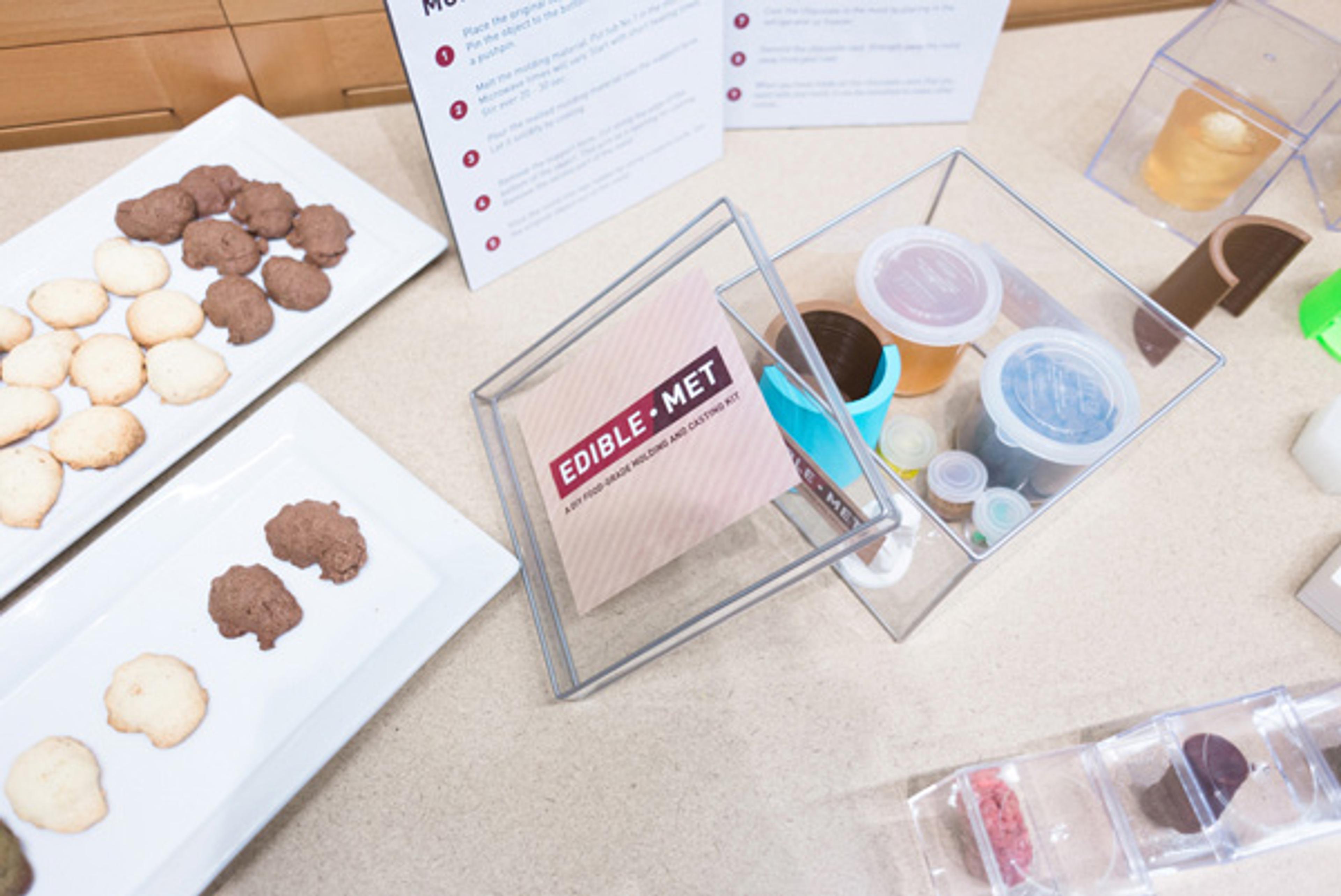
The EdibleMet food-casting kit, and some Marsyas cookies
Who doesn't love chocolate? Jimmy Tang and Yuanjin Zhao collaborated on a project that makes it easy to create your own custom edible art. Their Edible Met kit includes food-safe casting gel, a casting container, meltable chocolate, and a couple of 3D-printed art objects to get started with.
Additionally, they produced several dozen Marsyas-shaped cookies, and it was interesting to see how much detail could be removed yet the shape remain recognizable. Yum!
Picturing Met Museum

Helen D. Wall talks about the insights into visitors' photography habits revealed through her project, Picturing Met Museum
The Met's Flickr group has nearly 2,500 members and more than twenty thousand images. What are the Met's visitors posting there? What can that teach us about their behavior in our galleries? Helen D. Wall downloaded and hand-tagged thousands of Flickr images and loaded them into the data-publishing toolkit Silk to discover trends in Museum photography taken by the public.
The Flow Project

Left: QiuYi Wu and The Flow Project. Right: Young visitors play with The Flow Project in Carson Family Hall
For the first time, the Media Lab Expo featured an interactive component in Carson Family Hall—a gathering place for tour groups, and one of the few places in the Museum where it's OK for children to run around, jump up and down, and dance. QiuYi (Chewy) Wu took advantage of this opportunity by developing an interactive video wall that turns all that hyperactivity into impressionistic swirls of color and motion.
Diving into Pollock and Paintings Uncovered
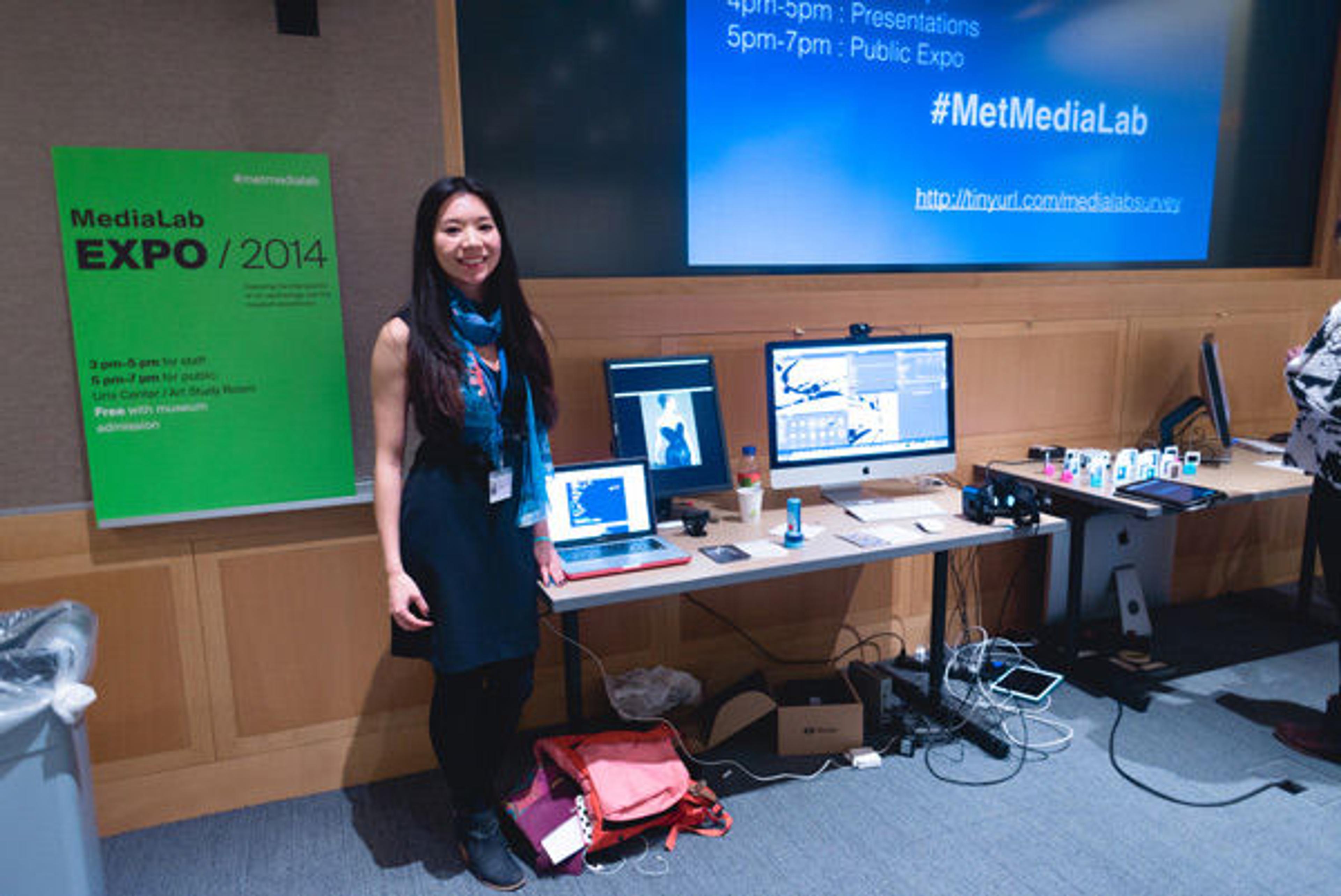
Betty Quinn with Diving into Pollock and Paintings Uncovered
Powerhouse developer Betty Quinn found time to deliver two projects to this semester's Expo. Diving into Pollock breaks with the tendency of virtual-reality experiences to recreate the real world, by putting the viewer in the middle of a Jackson Pollock painting, surrounded on all sides by faithfully rendered digital splatters.

Left: A visitor accesses Diving into Pollock via an Oculus Rift virtual-reality headset. Right: An infrared flashlight reveals hidden details in Paintings Uncovered
Paintings Uncovered provides the user with a "magic X-ray flashlight" which they could use to "look through" the classic Sargent painting Madame X (Madame Pierre Gautreau). Did you know that in an earlier version, Madame Pierre Gautreau's shoulder strap was shown slipping from her shoulder? A scandalized public compelled Sargent to revise it, but Quinn's flashlight reveals the hidden layers.
Sculptural Juxtapositions

Left: Stephanie Burgess with her two projects. Right: The 3D Art Mash-ups of Sculptural Juxtapositions
In Sculptural Juxtapositions, Stephanie Burgess also presented two projects that examined the way fictional and nonfictional narratives of art objects can be combined to create a commentary on the true nature of art. The Miniature Hybrid Met displays remixes of 3D art models that are combined with new stories, delivered via a RFID-enabled audio-guide experience.
In Burgess's interactive 3D environment, Symbolic Manipulation, users can interact and express themselves using their hands in midair. In this way they are able to create their own art piece composed of a variety of corporate and religious symbols.
Met Explorer

Left: Rodrigo Narciso Gouveia de Silva's mobile app. Right: De Silva demonstrates his wireframe and prototype of the mobile app to Museum staff
In a large, confusing space such as the Met, helping our visitors find their way around is always a priority for staff. The Media Lab has a history of developing projects to address this, from accessible wayfinding during the Met + Parsons Museum Accessibility Collaboration Workshop, to Yuliya Parshina-Kottas's pathfinding algorithms.
Rodrigo Narciso Gouveia de Silva and Xinyi Deng built on this workby developing wireframes and a working prototype that incorporates Yuliya's algorithm into a mobile app that shows the best route to see all your favorite works.
Multisensory Met
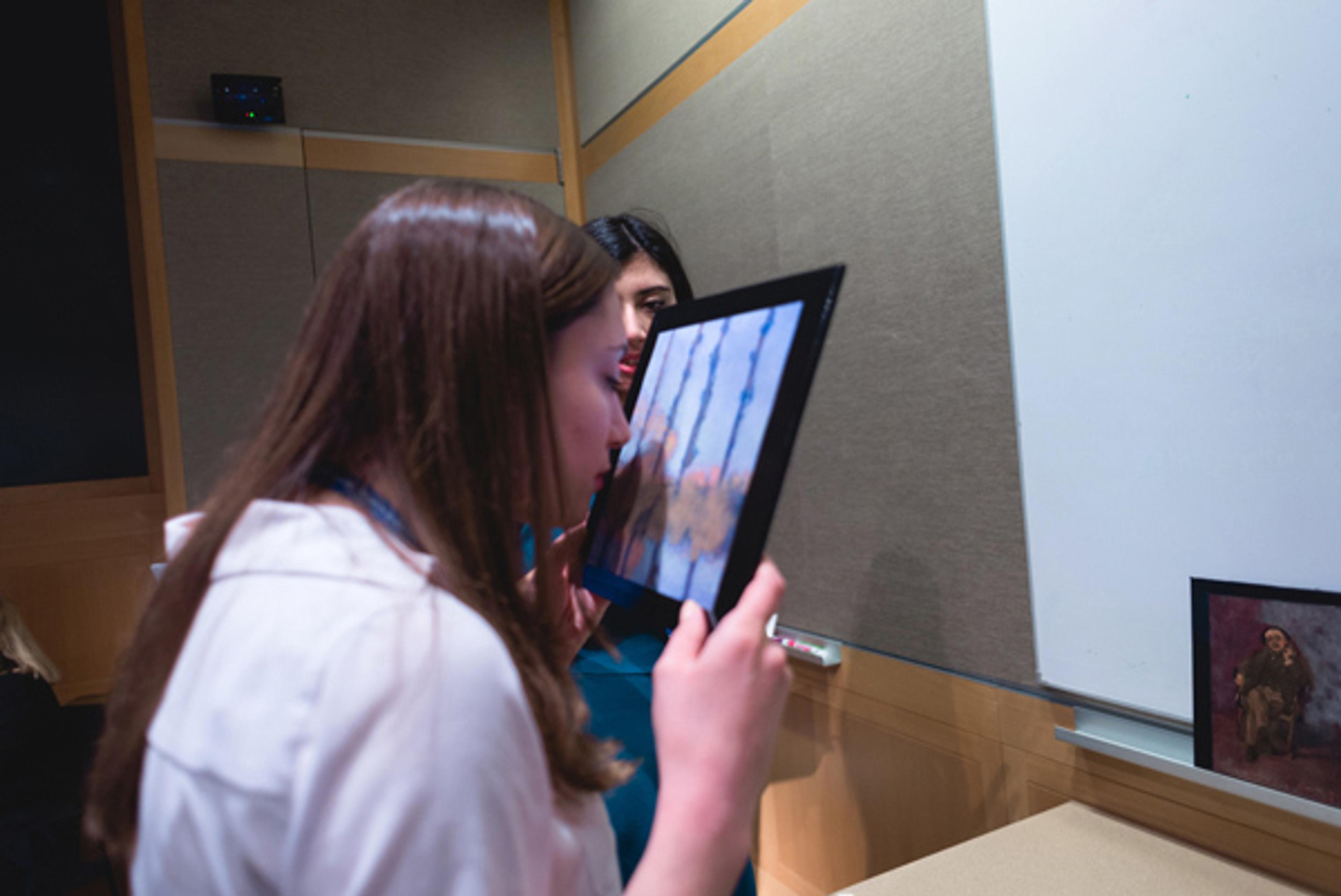
That's right, you can smell the art!
Of all the senses, smell is probably the most neglected in the arts. Yet smell is closely tied to emotion and memory in our brains. How can we use this sense to bring people into a close encounter with art? By creating scented versions of paintings, Ezgi Ucar started a conversation about how we can map aroma to vision and touch in compelling and memorable ways.
Beam Telepresence Robot

Left: The Beam Telepresence robot makes its debut bearing gifts at the Digital Media Department's staff holiday party. Right: Chief Digital Officer Sree Sreenivasan interviews Access Programs Coordinator Jan Ingvalson while she operates the Beam
The Media Lab, in partnership with our Access and Community Programs team and Suitable Technologies, is exploring ways that telepresence can help visitors with disabilities have a better experience in our galleries. While we are only in the early stages of development, we took advantage of the fact that there was a staff holiday party for the Digital Media Department next door to the Expo and had a little fun. We dressed up the Beam Telepresence device as a "Robo Butler," complete with bow tie, velvet-lined tray, and mannequin hands. Access Programs Coordinator Jan Ingvalson drove it from the Expo to the party, bearing gifts and treats created by Media Lab interns and staff.
Metropolitan Triangle Garden

Left: Rui Hu debuts the latest iteration of the Metropolitan Triangle Garden. Right: Screenshot from Metropolitan Triangle Garden. Image courtesy of the author
In the spring semester of 2014, Media Lab Intern Rui Hu developed a 3D animation called Metropolitan Triangle Garden, which used physical-modeling software to create a fantastical reimagining of a Met gallery, populated with morphing and disintegrating sculptures. At this Expo, Hu returned to debut an updated version that has been accepted into multiple film festivals in the interim. Due to agreements with those festivals, we are unable to embed the piece here, but trust me when I say it was jaw-dropping.
Thank You
The Media Lab at the Met is fortunate to have such incredible support from Museum staff, academia, and the creative-technology community and industry. In additional to our fabulous presenters, we'd also like to thank the following people for their efforts in making the Expo a great success: photographer Yulya Levit; Kevin Park and Natasha Mileshina, signage design; Keith Ozar and Leanne Gluck, 3D systems; Rebecca McGinnis, Marie Clapot, Jan Ingvalson, Christina Vanech, Access and Community Programs; Marlene Graham and the Uris Center Coordination Team; Paul Caro, Media Production; Suzanne Shenton and Visitor Services; Digital Media Administrators Ariel Estrada and Joan Kay; Paco Link, General Manager of Creative Development; and Chief Digital Officer Sree Sreenivasan.
Don Undeen
Don Undeen was formerly the senior manager of MediaLab in the Digital Department.